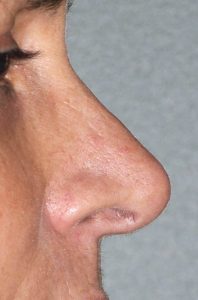Management of the tip of the nose in rhinoplasty surgery is the most dimensionally complex of all its potential shape changes. It is also open to high levels of scrutiny as it surrounded by easily identifiable landmarks as in the nostrils, columella and the protruding tip.

In the July 2021 issue of the journal Plastic and Reconstructive Surgery an article was published on this topic entitled ‘Lateral Domal Translocation and Medial Crural Transection: A Reliable Method for Nasal Tip DeProjection’. In this paper the authors employ the well known tripod concept in looking at tip projection and describe alar cartilage modifications as described in the title to do so.
Through an open rhinoplasty the lower alar cartilages are separated from their underlying vestibular lining by hydrodissection. A columellar strut graft is placed and is trimmed to the level of the desired tip deprojection. A new dome on each lateral crura is established by resection of a length of the the existing dome cartilages (intrinsic dome) to the level of the established deprojection point and sutured together across the top of the strut. The medial crura are then shortened, by transection or overlapping, to prevent excessive tip rotation and maintain the tripod relationships.
While numerous techniques have been described for tip deprojection, this described technique is anatomically sound and is reproducible. Its keeps intact the lateral crura and thus avoids the need for alar grafting. The authors decribe its limits as 4 to 5mms. As might be expected with tip deprojection the nasal base may become widened in appearance and nostril narrowing may also need to be done to keep a harmonious nasal width ti length shape.
Dr. Barry Eppley
Indianapolis, Indiana



